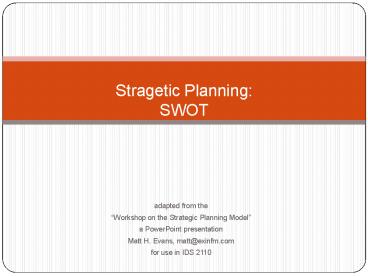Stragetic Planning: SWOT - PowerPoint PPT Presentation
1 / 12
Title:
Stragetic Planning: SWOT
Description:
Stragetic Planning: SWOT adapted from the Workshop on the Strategic Planning Model a PowerPoint presentation Matt H. Evans, matt_at_exinfm.com – PowerPoint PPT presentation
Number of Views:253
Avg rating:3.0/5.0
Title: Stragetic Planning: SWOT
1
Stragetic PlanningSWOT
- adapted from the
- Workshop on the Strategic Planning Model
- a PowerPoint presentation
- Matt H. Evans, matt_at_exinfm.com
- for use in IDS 2110
2
What is Strategic Planning?
- Process to establish priorities on what you will
- accomplish in the future
- Forces you to make choices on what you will do
- and what you will not do
- Pulls the entire organization together around a
- single game plan for execution
- Broad outline on where resources will get
allocated
3
Why do Strategic Planning?
- If you fail to plan, then you plan to fail be
- proactive about the future
- Strategic planning improves performance
- Counter excessive inward and short-term thinking
- Solve major issues at a macro level
- Communicate to everyone what is most important
4
Fundamental Questions to Ask
- Where are we now? (Assessment)
- Where do we need to be? (Gap / Future End
- State)
- How will we close the gap (Strategic Plan)
- How will we monitor our progress (Balanced
- Scorecard)
5
A Good Strategic Plan should . . .
- Address critical performance issues
- Create the right balance between what the
- organization is capable of doing vs. what the
- organization would like to do
- Cover a sufficient time period to close the
- performance gap
6
A Good Strategic Plan should . . .
- Visionary convey a desired future end state
- Flexible allow and accommodate change
- Guide decision making at lower levels
operational, tactical, individual
7
Strategic Planning ModelA B C D E
Where we are
Where we want to be
How we will do it
How are we doing
Assessment
Baseline
Components
Details
Evaluate
- Environmental Scan
- Situation Past, Present and Future
- Mission Vision
- Performance Measurement
- Performance Management
- Background Information
- Significant Issues
- Values / Guiding Principles
- Targets / Standards of Performance
- Review Progress Balanced Scorecard
- Situational Analysis
- Align / Fit with Capabilities
- Major Goals
- Initiatives and Projects
- Take Corrective Actions
- Feedback upstream revise plans
- Action Plans
- SWOT Strengths, Weaknesses, Opportunities,
Threats
- Specific Objectives
- Gaps
8
Assessment ModelS W O T
Internal Assessment Organizational assets,
resources, people, culture, systems,
partnerships, suppliers, . . .
External Assessment Marketplace, competitors,
social trends, technology, regulatory
environment, economic cycles .
SWOT
SWOT
Possible Pitfalls
Good Points
9
Strengths
- Strengths Those things that you do well, the
- high value or performance points
- Strengths can be tangible Loyal customers,
- efficient distribution channels, very high
quality - products, excellent financial condition
- Strengths can be intangible Good leadership,
- strategic insights, customer intelligence,
solid - reputation, high skilled workforce
- Often considered Core Competencies Best
- leverage points for growth without draining
your - resources
10
Weaknesses
- Weaknesses Those things that prevent you from
- doing what you really need to do
- Since weaknesses are internal, they are within
- your control
- Weaknesses include Bad leadership, unskilled
- workforce, insufficient resources, poor
product - quality, slow distribution and delivery
channels, - outdated technologies, lack of planning, . . .
11
Opportunities
- Opportunities Potential areas for growth and
- higher performance
- External in nature marketplace, unhappy
- customers with competitors, better economic
- conditions, more open trading policies, . .
- Internal opportunities should be classified as
- Strengths
- Timing may be important for capitalizing on
- opportunities
12
Threats
- Threats Challenges confronting the
organization, - external in nature
- Threats can take a wide range bad press
- coverage, shifts in consumer behavior,
substitute - products, new regulations, . . .
- May be useful to classify or assign
probabilities to - threats
- The more accurate you are in identifying
threats, - the better position you are for dealing with
the - sudden ripples of change

